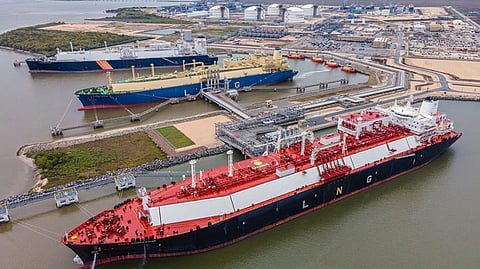US natural gas prices rise on higher demand, LNG export flows
US natural gas futures edged up about one per cent on Wednesday after dropping to an eight-month low in the prior session on forecasts for more demand over the next two weeks than previously expected and near-record gas flows to liquefied natural gas (LNG) export plants.
That small price increase came despite near-record output, ample supplies of the fuel in storage, and the approach of a storm that could affect the US East Coast as a demand-destroying hurricane next week.
Front-month gas futures for September delivery on the New York Mercantile Exchange rose two cents, or 0.7 per cent, to settle at $2.828 per million British thermal units.
On Tuesday, the contract closed at its lowest since November 14. The US National Hurricane Center projected Tropical Storm Erin will strengthen into a major hurricane as it moves west across the Atlantic Ocean toward the Bahamas by early next week. Meteorologists at AccuWeather project Erin will soak parts of Puerto Rico before sending rough surf and dangerous rip currents to the US East Coast.
In addition to Erin, the NHC said a disturbance in the western Gulf of Mexico had a 20 per cent chance of strengthening into a tropical cyclone over the next seven days.
Even though storms can boost prices by knocking Gulf of Mexico gas production out of service, analysts have said storms are more likely to cut demand and prices by shutting LNG export plants and knocking out power to millions of homes and businesses, which reduces the amount of gas that electric generators need to burn.
That is because only about two per cent of all US gas comes from the federal offshore Gulf of Mexico, while more than 40 per cent of the electricity produced in the US comes from gas-fired power plants.
Financial group LSEG said average gas output in the Lower 48 states rose to 108.2 billion cubic feet per day so far in August, up from July's record monthly high of 107.9 bcfd.
On a daily basis, however, output has dropped about 3.1 bcfd to a preliminary one-month low of 106.7 bcfd on Wednesday since hitting a daily record high of 109.7 bcfd on July 28. Preliminary numbers are often revised later in the day.
Meteorologists forecast the weather would remain hotter than normal through at least August 28 but would be cooler than previously forecast. Despite hotter-than-usual weather so far this summer, record output has allowed energy companies to inject more gas into storage than usual in recent months.
Analysts said gas stockpiles were about six per cent above normal levels for this time of year and were likely to keep growing in coming weeks.
LSEG projected average gas demand in the Lower 48 states, including exports, would ease from 111.4 bcfd this week to 111 bcfd next week. Those forecasts were higher than LSEG's outlook on Tuesday.
The average amount of gas flowing to the eight big US LNG export plants rose to 16.2 bcfd so far in August, up from 15.5 bcfd in July. That compares with a record monthly high of 16 bcfd in April.
The US became the world's biggest LNG supplier in 2023, surpassing Australia and Qatar, as surging global prices fed demand for more exports, due in part to supply disruptions and sanctions linked to Russia's 2022 invasion of Ukraine.
Gas was trading around $11 per mmBtu at the Dutch Title Transfer Facility benchmark in Europe and $12 at the Japan Korea Marker benchmark in Asia.
(Reporting by Scott DiSavino in New York; Editing by Andrea Ricci)


